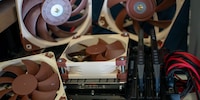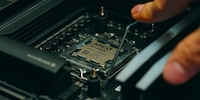
Threadripper 3970X on LN2 with extreme overclocker
Hiva Pouri is a multiple world champion in overclocking. In our studio, he overclocks the Threadripper 3970X with liquid nitrogen and explains what extreme overclocking is all about.
Overclocking is a science in itself. Extreme overclocking takes the whole thing to the extreme. This involves operating the CPU, RAM or GPU at a higher clock frequency than specified by the manufacturer. Where the components are cooled with fans or water in "simple" overclocking, other calibres are used in extreme overclocking.
Liquid nitrogen for the win
Air and water cooling always depend on the ambient temperature. If it is 20° Celsius in a room, the components will not get cooler than 20° due to the air or coolant. Extreme overclockers therefore rely on liquid nitrogen, or LN2 for short. Instead of the usual heatsink on the CPU, they use an LN2 pot, which is screwed onto the CPU and into which they pour liquid nitrogen. This is also how Hiva Pouri does it.
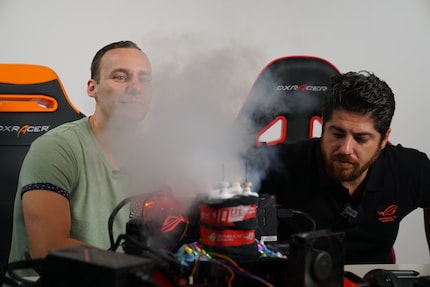
Hiva is a multiple world champion in overclocking. I met him for the first time at Computex 2019 at the G.SKILL Annual Overclocking Event. There he gave my colleague Martin and me a live insight into extreme overclocking. When Hiva is not busy overclocking, he works as a Product Manager at Asus Switzerland.
Hiva's workplace is just around the corner in Schlieren. When he got wind that I had a sample of the Threadripper 3970X to test, it was quickly decided that he would come by our studio and give us an insight into his skills.
A processor here, an LN2 pot there and some Vaseline for the motherboard
So that Hiva can prepare himself, I send him the processor in advance. He gets everything else himself: Benchtable, mainboard, RAM, power supply unit, graphics card, LN2 and LN2 pot. He coats the Asus Rog Zenith II Extreme motherboard with Vaseline to protect it from moisture and then assembles all the components.
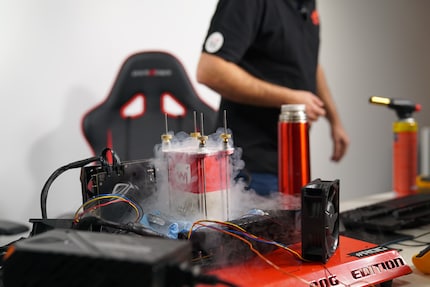
He arrives at the studio with this equipment. Hiva is visibly nervous, he doesn't like cameras very much, I already noticed that when we met at Computex. So I think it's all the cooler that he's here now.
Cold, colder, extreme overclocker
The native Iranian started overclocking in 2003. He watched other overclockers doing it, thought it was cool and has been doing it ever since. At first he overclocked with air, then in 2006 he started with LN2.
He treats the thermos flask in which he stores the liquid nitrogen for pouring like a natural arm extension. Hiva explains to me that extreme overclocking is basically about finding the balance between voltage, clock frequency and temperature. If the CPU is cooled down, it requires less energy. The temperature has an influence on the clock frequencies: If the CPU is cooler and therefore less energy-hungry, it can be supplied with a higher voltage, which in turn results in higher clock rates.
Theoretically, a CPU could be cooled down to -196° Celsius with LN2, the boiling point of liquid nitrogen. However, this is not the case for every CPU, Hiva explains. Certain CPUs have a so-called cold bug. This means that the system stops working above a certain temperature. There is also the cold boot bug. This occurs when it is no longer possible to boot from a certain temperature.
Let's bench
After these explanations, Hiva tries to find the optimum range between temperature, clock frequency and voltage. You can see what this looks like in the video above. He starts the Cinema 4D benchmark Cinebench R15 at around -68° Celsius, a clock frequency of 5 GHz on all 32 cores and a voltage of 1.5 volts. With these settings, we achieve a score of just over 6000 points. For comparison: The CPU achieves around 4500 points on the stock settings. Not bad for a start, but there should be a lot more to it, says Hiva.
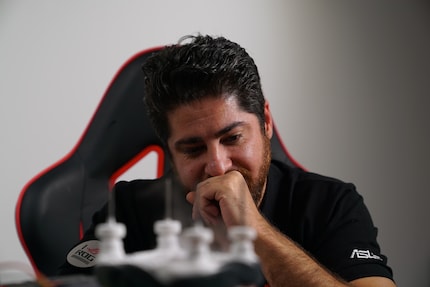
He tries 5.1 GHz on all cores. The system crashes. From this moment on, Hiva has problems rebooting the system. It doesn't want to. Hiva is not sure what the problem is. He tries to use a burner to bring the system back to a stable temperature, i.e. to override the cold boot bug. It doesn't work. After many unsuccessful attempts, Hiva gives up. Only when he dismantles the system does he realise that moisture has crept into a RAM bar. This is why the system no longer wanted to boot.
Hiva doesn't let up
Hiva wouldn't be a multiple world champion in overclocking if he was satisfied with the measly 6000 points. In peace and quiet and away from the cameras, he tries again - and with success. He realises that the CPU needs more voltage. Even at 5 GHz, the system runs more stable and faster at 1.55 volts than at 1.5, which is what caused the crash at 5.1 GHz. It clocks the system up to 5.223.78 GHz on all cores at a voltage of 1.648 volts. With 10,038, it is currently (9 January 2020) in the top 10 in Cinebench R15. In Cinebench R20, he even made it onto the podium with a score of 22,064: third place. Nervousness in front of the camera probably actually played a role here.
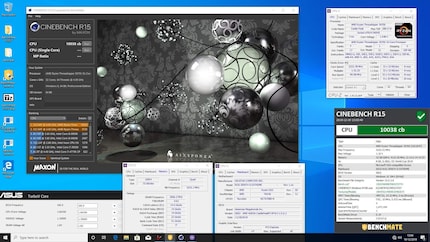
But more success in the Silicon Lottery than expected
Contrary to my conclusion in the video, the Silicon Lottery meant well with our Threadripper 3970X. The CPU can be overclocked relatively well. For me, it was an exciting experience to look over the shoulders of a professional overclocker like Hiva at close quarters.
Note: Caution is advised when handling liquid nitrogen. If you want to experiment with LN2 yourself, inform yourself in advance about the correct handling and observe the corresponding safety instructions.
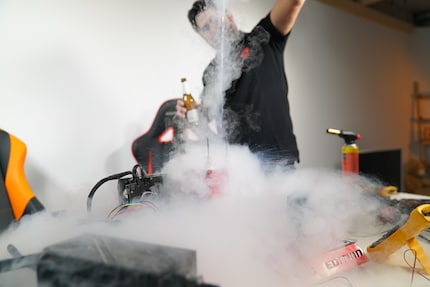

From big data to big brother, Cyborgs to Sci-Fi. All aspects of technology and society fascinate me.
Interesting facts about products, behind-the-scenes looks at manufacturers and deep-dives on interesting people.
Show all